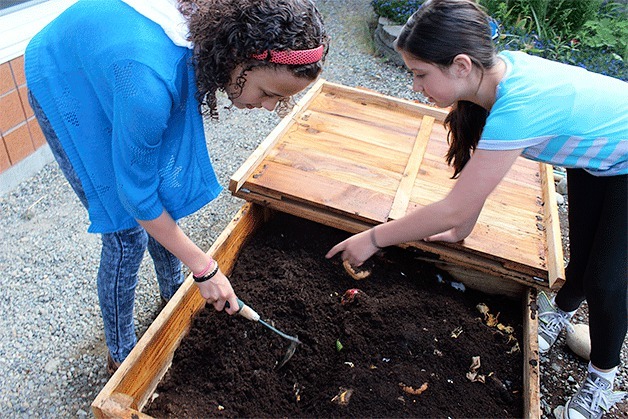Jada Miller can tell you about worms.
She can tell you how many segments are in their bodies and what happens if — oops — your garden shovel cuts one in half. She can tell you how to turn a simple wooden box into a black gold compost factory and what worms like to eat.
Even at 10 years old, Jada and many of her classmates can tell you quite a bit about not just vermiculture and composting, but gardening, recycling and even live poultry care.
That’s thanks to an innovative green push at Hillcrest Elementary that’s getting kids educated about environmentally-sound practices and giving them a chance to do scientific research that’s shared with agencies, including the state Department of Ecology.
In the past several years, the school has transformed a courtyard into a garden with raised beds for veggies and flowers, worms bins, rain barrels and an outdoor classroom. Another courtyard is the home of a flock of chickens.
Those chickens, by the way, are big-time celebrities. The chickens are visible through a bank of windows in a bustling school hallway. They have names like Clover, Lucky and Paddy. When anyone comes close to the window, the chickens rush over.
The school is recognized as a U.S. Department of Education Green Ribbon School, one of 35 elementary schools nationally to receive the designation. Island County also recently gave the school a Health Hero Award.
This project goes far beyond planting seeds and feeding chickens. Most of the teachers at Hillcrest incorporate the garden, chickens and worms into the curriculum.
Sometimes the garden serves as a quiet place to write or becomes the subject of a school writing assignment.
Students also collect data on the vermiculture project, recording how much waste from the cafeteria is fed to the worms and how many pounds of nutrient-rich castings are produced. They record the data and upload it onto computer notebooks to share.
The castings get incorporated into the school garden beds.
Very hungry worms in the school’s first bin ate more than 1,000 pounds of scraps from the cafeteria. So the school added a second bin, and worms have since munched hundreds of pounds more waste.
Fourth grade teacher Jodi Crimmins is excited her students are conducting real research and sharing it.
“They are just going for it,” she said. “They are inspired.”
The older students are teaching the younger ones. Jada Miller picked up a notebook filled with data and observations on a worm bin recorded by third graders she’s training. She giggled. “I love looking at this,” she said, and pointed to an entry by her younger charges about the worm bins. They recorded seeing “rollie pollie” bugs and “peep moss.” Jada figures they meant “peat moss.”
“The complete ownership of learning is on the students,” said Principal Paula Seaman. “It is actually the most empowering thing I have seen in my 25 years in education.”
Students also made commitments to do things like pick up trash, turn off lights and recycle. They’re bringing those lessons home — whether parents like it or not.
Emma Zamarripa, 10, encouraged her dad to start separating glass and the like from the trash for recycling.
“He didn’t like that at first because he had to separate the stuff and take it out of the house,” she said.
But now her family does, although Emma said her dad assigned somebody else the job: her brother.


